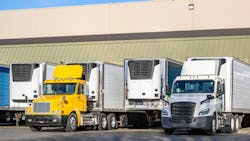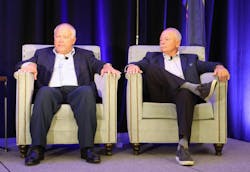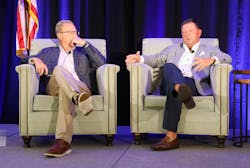Refrigerated outlook: Carriers cautiously optimistic about upcoming year
After dealing with plummeting spot and contract rates, excess capacity, and soaring equipment prices amid a prolonged trucking downturn, refrigerated carriers are hopeful the market finally turns in 2025. But they’re approaching the next cycle cautiously, especially when it comes to growing their fleets.
Hill Brothers Transportation, located in Omaha, Nebraska, now runs 250 tractors and 500 refrigerated trailers after trimming its fleet “substantially” over the last two years; KLLM Transport, based in Richland, Mississippi, is committed to a “lean” 1.4 truck-to-trailer ratio; and Leonard’s Express, headquartered in Farmington, New York, is down to 650 reefers after eliminating 75 last year.
“It depends on the customer and the relationship, but we’re going to look at this a lot differently than we did four or five years ago,” Ken Johnson, Leonard’s Express executive chairman, said during an economic outlook panel at the Truckload Carriers Association’s 2024 Refrigerated Meeting in Stowe, Vermont. “It seems like relationships have changed, and we’re taking that into consideration.”
Jim Richards, president and CEO of KLLM and Frozen Food Express—who run 3,300 trucks combined—insists carriers will need “double-digit” rate increases to make equipment expansion sustainable. “None of us need to add equipment,” he said. “But we’re not always the smartest people in the room, so if you throw a little money at us, it starts to look sexy—and we begin buying more trucks and trailers.”
Pete Hill, president of Hill Brothers, and moderator Thom Albrecht, CRO at Reliance Partners, joined Johnson and Richards for the rapid-fire discussion, which also touched on pre-buy strategies, private fleet impacts, minimum liability insurance requirements, and the evolving definition of a “good” customer.
Questions and answers are edited for length and clarity.
Albrecht: How well do your top customers understand your costs?
Johnson: “We’ve really tried to get in front of customers and have that conversation, especially in the last six months or so, and we’ve gotten a mixed bag of responses. We’ve heard, ‘You guys had a pretty good run during Covid. Now we need to make up some of our losses.’ And I’m like, ‘Yeah, we did well during Covid, but every single one of our costs went up. And guess what, none of them have come down.’ So the math isn’t making sense. And some of them are sympathetic, some of them pretend to be sympathetic, and with some, it clearly goes in one ear and out the other.
“When we were talking to one of our larger customers about cutting our fleet, we actually sat down and went through the numbers, and did some things on certain lanes that were beneficial for both of us. But that kind of conversation is rare. We don’t have many customers who have accepted that conversation. They’re taking advantage of the market, and when it changes, it changes, and we’ll have that conversation then, I guess.”
See also: Hill Brothers enjoyed elevated rates while they lasted
Albrecht: What’s your definition of a good customer? And how is that maybe different than a decade or so ago?
Hill: “We’re really seeing a delineation between our van shippers and our reefer shippers. With the reefer shippers, it’s the same stuff that’s been happening for the 50 years I’ve been doing this. The van carriers are looking for some stability, and they’re talking with us. We’re trying to work some things out.
“When I think about what makes a good customer, I look at payment terms first. If you pay me in 15 days, I love you. If you’re paying in 90 days, I’m trying to replace you. That’s it. And what we’re really looking for now is stability with customers, so we get that consistency, and not 14 loads one week and seven loads the next.”
Albrecht: Jim, do you see it differently?
Richards: “On the KLLM truckload side, our customer base is very stable. We don’t participate in the spot market, so everything we do, for the most part, is contract business. Our top 25 is probably 90% of our business, and we have long-standing relationships with them. So overall, our customers treat us well. We have some who try to take advantage of the situation, and those tend to be the ones driven by the procurement department who have less involvement with the transportation group in decision-making.
“But when the transportation folks are involved, we’ve done a good job of holding rates, and not giving up a lot. And we probably lost a little bit of market share, but we decided we’re not going backward.”
Albrecht: With RFPs, when capacity is loose, as it’s been the last couple of years, do you talk to customers about your costs and keeping lanes? Or does it overwhelmingly become a procurement event?
Hill: “It’s a lot more difficult. You used to be able to find a backdoor to get a few hints about what to do, and some of those back doors are being closed. I’ve been through so many of these, and it’s the same exact thing, and you sit back and laugh. So we decided we’re going to play our own game on the bids … because, quite frankly, it’s been a joke for so many years. They’ll bring in outside people, and they have a bid, then we spend the rest of the year clawing back to the original rate, and they turn around and rebid. [We ask,] ‘Why are you rebidding this thing?’ [and they say,] ‘Because every time we rebid, we save money.’ Well, they think they save money, but essentially, they don’t.
“So, being a little bit more interactive [might be helpful]. Give us those hints. We’re trying to give you what you want.”
See also: Carriers convene at TCA reefer convention
Albrecht: When you lose 15-25% of your business, it not only impacts your bottom line, all of a sudden your network looks completely different. Do you get to explain these new challenges amid all this chaos?
Richards: “There isn’t a lot of conversation surrounding bids, even in the good times when customers are bidding frequently. We complain about that because it does upset your network. You’ve matched things up well, and the next thing you know you’ve got to bid again, and the whole business changes. So that’s always a problem. But one of the things I’ve seen this year, which I haven’t seen before—or at least not to this magnitude—is a lot of large customers, even in times like now, are steering away from brokers and 3PLs because, in the last cycle around Covid, when the spot market ran up so high, a lot of them got burned. They were paying $4 a mile because they couldn’t get capacity from contract carriers, and that’s still on their minds. They know the day is coming when it’s going to turn, and they don’t want to be in a position where they’re dependent on the spot market. So we’ve been able to maintain some of our volumes because they moved it back to contract carriers.
“Now, they’re able to do that right now at a good rate. So they’re enjoying great service with well-known carriers at a decent price. But even when the price changes, I think they understand they’ll be better off with a contract carrier at a pretty good rate, giving good service, vs. going out there in the spot market, paying exorbitant rates, and not really knowing who’s handling your business.”
Albrecht: When the shipper runs a large private fleet, are you still getting good opportunities, or is it scraps?
Hill: “We’re getting the scraps. That’s the way it is.
“You have to look at who you are. We were a growing carrier—on our way to 600 trucks—and then we decided we could probably make more money at 250 trucks that 385, and it’s a mindset change. So, when you’re talking to customers, and you’re not this growing company anymore, they look at you differently. I look at the freight we used to haul and now it’s being hauled by the private fleet, their super-dedicated fleet, or their top-tier carrier. And then what’s left? We’re getting access to maybe 30%. This is where we come back in and talk about flexibility. One of the things we got during Covid was flexibility, so we say, ‘If you want to use this hybrid model, with our assets and logistics, to help you haul your freight, we need access to more of your freight.’ So we’ve been able to push that a little bit to try to get away from the scraps.”
Albrecht: Is dedicated service becoming more of a commodity like over-the-road business?
Richards: “It’s still specialized. It’s not a huge difference in margin, but it’s consistent, steady business we enjoy. We run about 300 trucks with Tyson, and they probably have about 1,000 trucks, and ours are thrown into the mix with theirs. Our trucks are in their system, they plan them, and basically all we do is dispatch and pay the drivers. But in our experience with shippers that have private fleets, carriers aren’t just getting scraps, per say. For instance, Tyson knows where they have trucks, so they define an area and keep us in it. They might not want to send their trucks to the West Coast, for example, so they use common carriers for some of that business. So it’s not scraps, it’s more where it makes sense for them to have their fleet.”
Albrecht: Shippers previously used their fleets to fill in areas where they had trouble finding OTR solutions. Are they chipping away at some of the better lanes now, too?
Johnson: “We’ve seen less volume, rather than shippers taking the better lanes. They grew their fleets during the pandemic, simply because they were looking for capacity. I don’t see any instances where lanes aren’t in the RFP because they’re saving it, but with the volume, they’re going to load their trucks first. Contract carriers like us get what doesn’t fit their network. If they used to have 10 loads, and now they only have five, their trucks get those first five. So, it’s more of a capacity issue than the lengths we run.”
See also: How for-hire trucking performed in June
Albrecht: Do we need higher auto liability minimum requirements?
Johnson: “We have a logistics side, so we deal with a lot of small fleets, and obviously it’s a financial impact to them, but it’s long overdue. I’ve heard a lot of big numbers. I’m not sure it needs to go as high as some of the suggestions, but it certainly needs to be a lot higher than it is now, from a competitive standpoint, and to ward off carriers that maybe shouldn’t be out there. The current minimum allows them to keep operating in some cases.”
Hill: “I’d be happy with double [the current FMCSA minimum].”
Richards: “The fact of the matter is, it’s been $750,000 since the early 80s. We all know what’s happened in litigation, with some of these lawsuits, so it’s hard to argue $750,000 is an adequate number. Unfortunately, some of us must carry very large premiums. We have $80 million worth. So to me, it’s about being responsible and doing the right thing, and no one believes $750,000 is enough if a family of four dies in an accident.
“It should probably be $2.5 million—at a minimum. That would be reasonable.”
Albrecht: Refrigerated trailer prices have been very inflationary over the last decade. Is that likely to continue over the next five years?
Johnson: “I’m hoping they’re going to be more friendly. It’s been a challenge keeping up with equipment costs. I don’t see it going backward. I hope it stays closer to the inflation we’re seeing, so we’re able to stay competitive, but we may have to make changes to our trade cycles.”
Albrecht: When shippers don’t have private fleets, do they care about reefer trailer prices?
Richards: “They’re not as sensitive to it. That’s a good thing about dealing with customers who do have their own fleet. They’re more in tune with what we’re experiencing, and more willing to work with us.”
Albrecht: Can you extend reefer trailer lifespans if shippers are sympathetic?
Hill: “We’ve extended reefer lives. The best equipment starts in our long-haul fleet. Then we’ll move it into our regional fleet, and we also have a local fleet we can run it in. And I don’t see prices coming down either.”
Albrecht: Jim, you mentioned KLLM’s trailer-to-tractor ratio. A lot of reefer carriers have inched closer to 1.8 over the last 10-15 years. How have you been able to hold at 1.4?
Richards: “We manage trailers very closely. That’s a situation we look at every day. They’re so expensive, and most of what we do is drop-and-hook. We do very little live loading and unloading. So, with the price of trailers, we manage them very closely. That’s a key data point we keep an eye on.
“We’ve continued to run very low ratios, and it’s just about discipline.”
Albrecht: What about Leonard’s Express?
Johnson: “Our reefer ratio has remained stable. Unlike KLLM, we do live load most of our freight, and our length of haul on the refrigerated side is long, just under 1,000 miles, so we don’t need all the extra trailers. Most of our extra units are for maintenance, so we don’t have a lot of reefers sitting around.”
Albrecht: Pete, do you have anything to add?
Hill: “Our ratio is much higher. When we reduced our fleet, we kept a lot of trailers because we decided to use them to our advantage. Does that mean we cash out, or do we deploy excess trailers to our customers to get more freight? Where we’re at, in the Upper Midwest, in a meat patch, we’ve found that if you have empty trailers at customers’ facilities, they’ll load them. There was a weakness in the software, years ago, where if we were second or third on the list, we could still get the freight we wanted because we flooded their yards with empty trailers. That’s not as big of an advantage as it used to be, but it’s still beneficial to roll them out 2-to-1 in our area because we can get the freight we want.”
Albrecht: What has it been like dealing with sky-high prices for spare parts?
Richards: “One of the things that has been different this cycle than previous ones is the level of cost increases we’ve all incurred. We’ve always had 2-3% increases. Our parts and labor prices are up 57% over the last two years. And not having the ability to pass those types of increases on to customers creates issues. That’s why this downturn has been so bloody. It’s been longer than some cycles we’ve seen, and it’s certainly been more traumatic, and it’s because of the increases. Not only parts, but the cost of trailers, the cost of trucks—all those numbers are up, significantly.
“The availability of parts and components remains tight, even after Covid. We run four football equipment trucks for Ole Miss, Mississippi State, Southern, and Jackson State, and those trucks were delayed several months because they didn’t have frames. So we’re still seeing those kinds of things. We had a conversation with Freightliner about pre-buying not too long ago, and they said there isn’t going to be a pre-buy because they don’t have enough components to support pre-buying.”
Albrecht: With looming changes to emissions regulations expected to accelerate price increases, will you consider a pre-buy—if it’s possible—and maybe try to spread it out?
Johnson: “We’ve always tried to maintain consistency in our purchasing. We’ve looked at pre-buys, but maybe 5% is the most we’ve ever done. That’s what made sense to us. And we’ve had the same conversations [as Richards]. Even if we wanted to pre-buy, we’re probably not going to be able to get what we want.”
Hill: “The way we look at it, when something new comes out, the first model year usually has problems, so we try to buy less of those, and more of what works. It’s a guessing game anymore, but the first model year consistently is weak. So we’re not trying to game the system or make money on trucks down the road. Let the people who buy and sell trucks make money that way. We’re just looking at overall operating cost and uptime.”
Albrecht: If no one can pre-buy because of the component issue, doesn’t that mean everyone’s fleets are going to get older ahead of the first mandate? And does that create a new wave of problems for trucking?
Richards: “It could. There certainly are higher maintenance costs associated with running older equipment, and many of us probably didn’t buy a lot of trucks this year. We didn’t. That’s naturally going to leave us with some catching up to do, so some of that is going to happen, outside of the new equipment regulations coming. So I do think we’re going to see the number of purchases go up in the next couple of years.
“Now, we do things a little differently, because we have our own equipment sales and leasing company. Historically, we would run trucks four years, 550,000 miles. Now that we’re in the sales business, we really watch the market, and we don’t necessarily keep trucks and trailers for a certain period of time. If the market gets hot, and we can sell a 2-year-old tractor and make a good bit of money, we’ll do that.”
About the Author

Jason McDaniel
Jason McDaniel, based in the Houston TX area, has nearly 20 years of experience as a journalist. He spent 15 writing and editing for daily newspapers, including the Houston Chronicle, and began covering the commercial vehicle industry in 2018. He was named editor of Bulk Transporter and Refrigerated Transporter magazines in July 2020.



